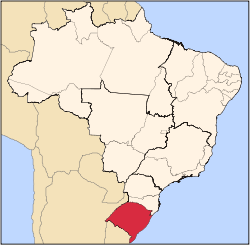Imigrante | |
|---|---|
 Geograpichal divisions of Rio Grande do Sul. Imigrante is highlighted in red. | |
| Coordinates: 29°21′18″S51°46′37″W / 29.35500°S 51.77694°W | |
| Country | Brazil |
| State | Rio Grande do Sul |
| Incorporated | May 9, 1988 |
| Government | |
| • Mayor | Paulo Gilberto Altmann (PP) |
| Area | |
• Total | 73,355 km2 (28,323 sq mi) |
| Elevation | 100 m (300 ft) |
| Population (2022 [1] ) | |
• Total | 3,080 |
| • Density | 39.9/km2 (103/sq mi) |
| Time zone | UTC−3 (BRT) |
| Website | imigrante-rs.com.br |
Imigrante (population: 3,080) is a city in Rio Grande do Sul, located in south Brazil, situated in the state's Taquari Valley region. It was established by German and Italian immigrants. Imigrante calls itself, Terra do Cactos, or Land of the Cactus.
Contents
The city is 100 m above sea level. Its climate is subtropical.
Imigrante's economy centers on the metallurgy industry.
The mayor is Paulo Gilberto Altmann, of the PP party.








